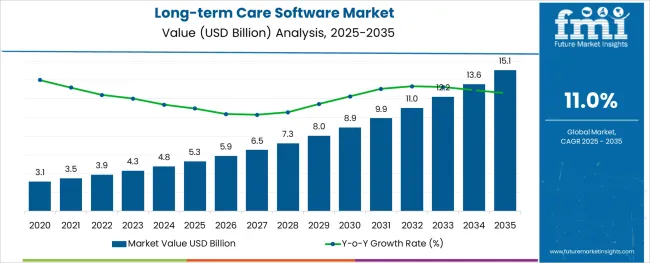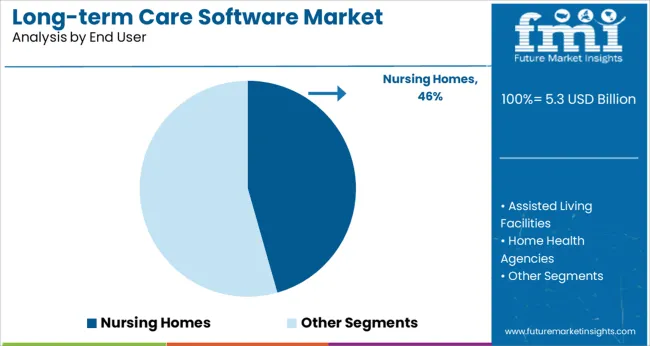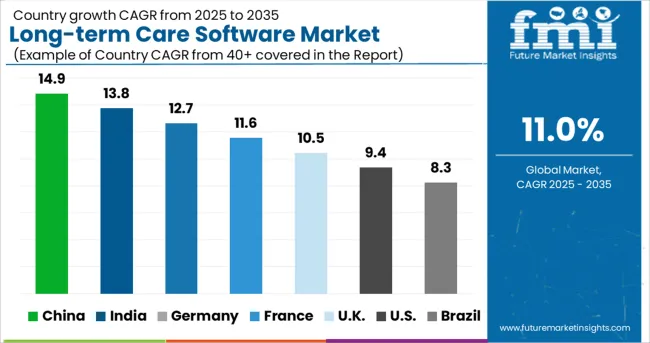The Long-term Care Software Market is estimated to be valued at USD 5.3 billion in 2025 and is projected to reach USD 15.1 billion by 2035, registering a compound annual growth rate (CAGR) of 11.0% over the forecast period.

The long-term care software market is expanding steadily as healthcare providers seek efficient management solutions for aging populations and chronic disease care. Advances in digital health and increased adoption of telehealth have accelerated demand for software platforms that improve patient data management, care coordination, and regulatory compliance.
Cloud-based delivery models have gained traction due to their scalability, remote access capabilities, and lower upfront costs. Providers are prioritizing software that facilitates seamless communication between caregivers, patients, and family members.
Additionally, the growing number of nursing homes and assisted living facilities worldwide has heightened the need for integrated care management systems that support documentation, billing, and quality control. Future growth is expected to be driven by innovations in AI-powered analytics, interoperability with electronic health records, and mobile-friendly interfaces. Segmental demand is anticipated to be led by cloud-based delivery and nursing homes as the primary end users.
The market is segmented by Delivery Modes and End User and region. By Delivery Modes, the market is divided into Cloud-based, On-premises, and Web-based. In terms of End User, the market is classified into Nursing Homes, Assisted Living Facilities, and Home Health Agencies.
Regionally, the market is classified into North America, Latin America, Western Europe, Eastern Europe, Balkan & Baltic Countries, Russia & Belarus, Central Asia, East Asia, South Asia & Pacific, and the Middle East & Africa.

The cloud-based delivery mode segment is projected to capture 49.3% of the long-term care software market revenue in 2025, establishing itself as the leading mode of software delivery. Growth in this segment is driven by the flexibility and accessibility cloud platforms offer to care providers.
Cloud-based solutions enable real-time data sharing across multiple locations which is critical for coordinating long-term care services. The reduced need for on-premise infrastructure lowers barriers to adoption especially for smaller facilities.
Moreover, cloud software supports regular updates and security enhancements without service interruptions. As the long-term care sector continues to embrace digital transformation, the cloud-based delivery mode is expected to remain the preferred choice for software deployment.

The nursing homes end user segment is projected to account for 45.6% of the market revenue in 2025, maintaining its position as the largest user group. This segment’s growth is attributed to the increasing demand for efficient care management solutions to handle complex patient needs, regulatory requirements, and staffing challenges in nursing homes.
Facilities are investing in software that streamlines patient record keeping, scheduling, medication management, and billing processes. Nursing homes require systems that enhance communication among healthcare teams and improve care quality for long-term residents.
With the ongoing rise in elderly populations globally, nursing homes are expected to continue driving the adoption of long-term care software to optimize operational efficiency and patient outcomes.
The demand for long-term care software is expanding as a result of the digitalization of healthcare technologies. The long-term care software market's primary growth drivers include changing healthcare infrastructure, a staffing shortage, and the use of technological solutions in healthcare institutions.
The sales of long-term care software are also expanding due to a shortage of healthcare professionals and various efforts made by governments around the world to lower medical costs.
In addition, the rising use of mobile devices in healthcare organizations and the rise in the number of healthcare organizations are the major drivers of the long-term care software market expansion.
Due to advancements in the effectiveness and safety of drug treatment over the past few years, long-term care software has attracted a great deal of attention.
The primary reason driving the increase in demand for long-term care software is the growing requirement for healthcare IT solutions to boost long-term care facilities' operational effectiveness.
The long-term care software market outlook is expanding due to numerous government initiatives taken by governments around the world to reduce the rising expense of healthcare.
Applications of long-term care software, such the long-term care software, can manage remote patient video conferencing, scheduling, and messaging, analyze millions of data records, and swiftly identify possible difficulties before they become problems.
The primary factor that could hinder the growth of the long-term care software market in the near future is the high cost of software maintenance.
Furthermore, another possible challenge impeding the growth of the long-term care software industry in the near future is the resistance of the traditional long-term care providers to adopt new software.

Due to the widespread use of long-term care software in this region, North America dominates the global long-term care software market with a share of 30.0%.
Due to the healthcare sector's rapid development and the widespread use of web-based and cloud-based long-term care software in developing nations, Europe is one of the regions with the highest expectations for growth in the long-term care software market.
Europe is anticipated to hold 19.7% of the overall long-term care software market share. Due to the healthcare industry's rapid infrastructure development, Europe's long-term care software market is anticipated to increase its share significantly throughout 2035.
Additionally, due to government initiatives in the healthcare sector by emerging economies like India, China, and Japan, APAC is anticipated to have the greatest growth in the long-term care software market.
The National Institute on Aging (NIA) supports and assists in undertaking research on aging, as well as the health and wellbeing of senior citizens.
The National Association of States United for Aging and Disabilities (NASUAD), the Long-Term Care Choices Navigator in Minnesota, the Massachusetts Department of Elder Affairs, and the Georgia Department of Human Services (DHS) Division of Aging Services are just a few of the state-level initiatives.
Due to the advancement of digital technologies and the rising use of mobile devices in the region's healthcare industry, the long-term care software market in Latin America and MEA is anticipated to experience rapid expansion over the next years.

Allscripts Healthcare Solutions, Inc., Cerner Solutions, Omnicare, Inc., Omnicell, Inc., HealthMEDX, LLC, McKesson Corporation, Optimus EMR, Inc., PointClickCare, MatrixCare, and SigmaCare are some of the key players in long-term care software market.
| Report Attribute | Details |
|---|---|
| Growth Rate | CAGR of 11% from 2025 to 2035 |
| Base Year for Estimation | 2024 |
| Historical Data | 2014 to 2024 |
| Forecast Period | 2025 to 2035 |
| Quantitative Units | Revenue in million and CAGR from 2025 to 2035 |
| Report Coverage | Revenue Forecast, Volume Forecast, Company Ranking, Competitive Landscape, Growth Factors, Trends and Pricing Analysis |
| Segments Covered | Delivery modes, End-users, Region |
| Regions Covered | North America; Latin America; Europe; East Asia; South Asia; Oceania; Middle East and Africa |
| Key Countries Profiled | USA, Canada, Brazil, Argentina, Germany, UK, France, Spain, Italy, Nordics, BENELUX, Australia & New Zealand, China, India, ASEAN, GCC, South Africa |
| Key Companies Profiled | Cerner Corporation; Omnicare Inc; AOD Software; Kronos; PointClickCare; Omnicell, Inc; McKesson Corporation; Allscripts Healthcare Solutions, Inc.; MatrixCare; SigmaCare; Optimus EMR; HealthMEDX LLC. |
| Customization | Available Upon Request |
The global long-term care software market is estimated to be valued at USD 5.3 billion in 2025.
It is projected to reach USD 15.1 billion by 2035.
The market is expected to grow at a 11.0% CAGR between 2025 and 2035.
The key product types are cloud-based, on-premises and web-based.
nursing homes segment is expected to dominate with a 45.6% industry share in 2025.






Full Research Suite comprises of:
Market outlook & trends analysis
Interviews & case studies
Strategic recommendations
Vendor profiles & capabilities analysis
5-year forecasts
8 regions and 60+ country-level data splits
Market segment data splits
12 months of continuous data updates
DELIVERED AS:
PDF EXCEL ONLINE
Suncare Products Market Size and Share Forecast Outlook 2025 to 2035
Skincare Supplement Market Size and Share Forecast Outlook 2025 to 2035
Skincare Oil Market Size and Share Forecast Outlook 2025 to 2035
Lip Care Market Analysis - Size and Share Forecast Outlook 2025 to 2035
Skincare Nutritional Serum Market Size and Share Forecast Outlook 2025 to 2035
Haircare Supplement Market - Size, Share, and Forecast Outlook 2025 to 2035
Skincare Products Market Size and Share Forecast Outlook 2025 to 2035
Lip Care Packaging Market Size and Share Forecast Outlook 2025 to 2035
Skincare Market Analysis - Size, Share, and Forecast Outlook 2025 to 2035
Sun Care Products Market Analysis – Growth, Applications & Outlook 2025–2035
Skincare Packaging Market Size, Share & Forecast 2025 to 2035
Pet Care Market Analysis – Demand, Trends & Forecast 2025–2035
Car Care Products Market Trends - Growth, Demand & Analysis 2025 to 2035
Pet Care Packaging Market Insights - Growth & Forecast 2025 to 2035
Eye Care Supplement Analysis by Ingredients, Dosage Form, Route of Administration, Indication, Distribution channel and Region 2025 to 2035
Homecare Medical Devices Market Outlook – Industry Growth & Forecast 2025 to 2035
Skincare Industry in India – Trends & Growth Forecast 2024-2034
Global Skincare Treatment Market Analysis – Size, Share & Forecast 2024-2034
Pet Care Ingredients Market
Homecare Dermatology Energy-based Devices Market Growth – Trends & Forecast 2018-2028

Thank you!
You will receive an email from our Business Development Manager. Please be sure to check your SPAM/JUNK folder too.
Chat With
MaRIA